Project News
2009-06-15
Beginning Activities in Small Communities
Until now, the Project has focused its efforts on the relatively larger communities in its object area, where it formed farmer groups that carry out the activities. However, in order to achieve a more effective management of the watershed, activities need to be developed in the small, isolated communities that receive almost no aid from the outside (and where there are more farmers still practicing the traditional slash-and-burning farming methods). Therefore, our Project decided to cooperate with the Chagres National Park's administrative office and initiate activities in these small communities.
Since the inhabitants of such communities are often reticent to speak with outside people, we used the strategy of beginning our activities with the school students. In this way we could establish a trust relationship with the parents of the students and gradually expand our activities to include them as well. The order in which the initial activities are carried out is as follows:
- Select the object communities;
- First visit to the object community and its elementary school;
- Talk with the schoolteacher to obtain her/his acceptance and agreement to participate in the activities;
- Hold environmental education activities for the students (talks, puppet show, etc.);
- Make a school garden for organic farming with the students. Hopefully the parents of the students will also participate.
- Give an environmental education talk to the parents using simple materials;
- Take a study tour to one of the group farms (both students and parents participate);
- Plan the next activities together with the inhabitants of the object community.
The following communities and schools were visited for the purpose of beginning the above activities: on June 4, Quebrada Fea community (8 families, about 30 inhabitants, multi-grade school with 8 students and 1 teacher); on June 5, Quebrada Benitez community (8 families, about 30 inhabitants, multi-grade school with 6 students and 1 teacher). The teachers were interviewed and the purpose of the visit was explained to them. Both teachers agreed to participate in the activities. From now one, we will carry out our activities once a month with the communities, starting with environmental education for students and making a school garden.
The photos are from the Quebrada Fea community that we visited on June 4.
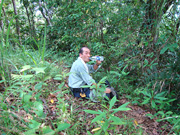
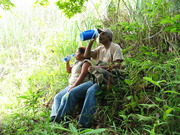
(Photo 1: left) Mr. Carrion, in charge of technical extension, and Ms. Suleima, in charge of participatory development, stop to drink water and replenish their strength.
(Photo 2: right) Mr. Sakai, Chief Advisor, also quenchs his thirst.
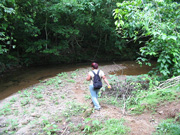
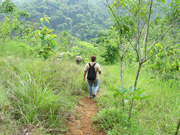
(Photo 3: left) After getting off the boat at the lakeshore, we climb hills...
(Photo 4: right) ...and cross rivers walking for three hours to arrive at the community. (It really did take three hours.)
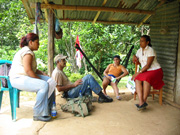
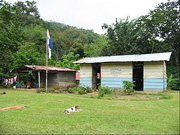
(Photo 5: left) At last, we arrive at the Quebrada Fea school. It is a small school. The house behind the school is the teacher's residence.
(Photo 6: right) Explaining the purpose of our visit to the teacher (right). She said she has been teaching in this school for 5 years. I was very inspired by her.
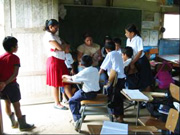
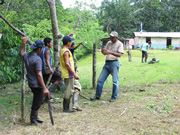
(Photo 7: left) Mr. Carrion doesn't lose a minute to talk with the local farmers about organic farming. He is dedicated to his work.
(Photo 8: right) Ms. Suleima shows the boys and girls the handicrafts made from plastic bottles. She is likewise very dedicated. I didn't want to be the lazy one among the three of us, so I made "origami" (folded paper figures) that I gave away to the teacher and students. Will this open the door for them to accept our activities?
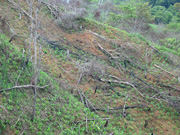
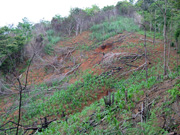
(Photos 9 & 10) We saw slash-and-burn farming on the hillsides we passed on the way to the Quebrada Fea community. Rice was planted without taking measures to prevent soil erosion. When we see such situations, it strengthens our resolve to further promote conservation activities.
(Mr. Isao SAKAI, Chief Advisor / Rural Development)
